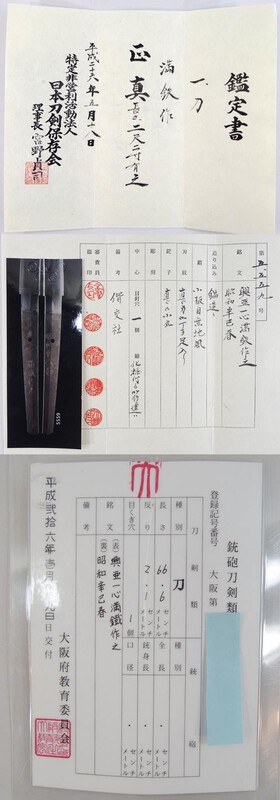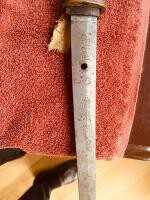-
Posts
13,937 -
Joined
-
Last visited
-
Days Won
169
Content Type
Profiles
Forums
Events
Store
Downloads
Gallery
Everything posted by Bruce Pennington
-

Pictures Of "tanker"
Bruce Pennington replied to Ontario_Archaeology's topic in Military Swords of Japan
Do I recall that there were a rare few leather covered saya in the "old" days, but not the norm? Regardless, the leather on the tanto you mention is obviously new, as in WWII, though, which was a norm for refitting blades for the war. Seems like I saw a photo recently of a trooper with a leather covered tanto slung on his gear. -

Japanese Vet Bring Back Ww2 Sword Help
Bruce Pennington replied to Mike A's topic in Military Swords of Japan
The blade looks legit. I've balked on "writing" of this style because it looks like something etched on with a hot iron. I've seen this style before and guys at the time said it's completely legit method of marking blades. I'd love to hear DaveR's thoughts on the koshirae. It looks like it spent some time in occupied lands and was refitted by locals. The date is interesting as the "new" style was reintroduced in '34 right? So this is quite an early blade for a shingunto. I like it. Dave, you there? -

Copper Nco Out There To Examine
Bruce Pennington replied to zook's topic in Military Swords of Japan
Dan, You're right about the saya, it's mis-matched. The handles are copper, not brass, and this one looks good. The blade has no inspector stamp, but it's seems I've come across that before, and as no one really knows the final serial number of the last copper handled 95 made, this one must be pretty darn close, so would be a great collector item. Waiting for Steve or Stegel or Stu's thoughts. -

Pictures Of "tanker"
Bruce Pennington replied to Ontario_Archaeology's topic in Military Swords of Japan
Thanks Neil. Not that they're wrong, either. The issue I tried to narrow down with Nick was that the order he found directing the Gunzoku to use the all-brown tassel just says they are to use it. But, where did it come from? Was it already in use by the IJA, and the Gunzoku were just added to the list of users? Or did this directive create a heretofore unheard of all-brown tassel? The order doesn't create a tassel, it simply tells uniformed civilians to use one. His answer was that there was no mention of an all-brown tassel in IJA uniform regulations prior to the 1940 revision. While I'm aware that it's impossible to prove, with evidence, that something DOESN'T exist, I don't feel that simply using uniform regulations is full proof. It would take the orders/specs from the govt to the contracting community directing the production of the all-brown tassel (and the date it happened) to actually nail this one down. So, to me, it's still possible that IJA officers, or in your example, late-war NCOs, were using these as well. But until we get some documentation to prove one way or the other, we're still dealing in possibilities. -

Pictures Of "tanker"
Bruce Pennington replied to Ontario_Archaeology's topic in Military Swords of Japan
Neil, I'm curious about your source on this. It's my understanding that the all brown was used by the uniformed civilian corps (Gunzuko, I believe), so an NCO or Lance Corporal equivalent might have carried that arrangement if I understand the latest on these correctly. Discussed here: http://www.warrelics.eu/forum/Japanese-militaria/what-were-regulations-army-civilian-employees-carry-swords-701783/ -
Interesting Neil. Do those pins or rivets in the kabutogane go all the way through?
-

Koa Isshin With Nthk Papers
Bruce Pennington replied to PNSSHOGUN's topic in Military Swords of Japan
Thanks John. We’re anxious to hear what Chris finds out. -
No, only upgrades. So you must be seeing higher quality Type 3’s, eh?
-

Pictures Of "tanker"
Bruce Pennington replied to Ontario_Archaeology's topic in Military Swords of Japan
I have read that carrying swords on the airplane was discouraged, some guys did it anyway though. -
I’ve never read or heard a reason. They do appear most often on blades that are high-quality gendaito. Usually star stamped RJT blades .
-

Koa Isshin With Nthk Papers
Bruce Pennington replied to PNSSHOGUN's topic in Military Swords of Japan
Neil, Your question got lost in the hubbub - I think you're onto something. The lowest rating, Shinteisho, simply states that the mei is original. Kanteisho states the mei is original and the blade is "important" or "quality" work. As we all know, the Mantetsu operation made quality blades and was an important contribution to the resurrection of the katana. What I'm hoping to find out from Chris Bowen is the "charter", so to speak, of the rating societies. Why do they exist? Are they chartered to only evaluate traditionally made nihonto? Or is their mission to evaluate/preserve high-quality Japanese made blades? Are they expanding their mission? Inquiring minds want to know! -

Koa Isshin With Nthk Papers
Bruce Pennington replied to PNSSHOGUN's topic in Military Swords of Japan
Thanks to Guy, the rating given on this is: 鑑定書 Kanteisho Which is: “This is the second highest and more commonly seen origami certificate from the NTHK-NPO that offers a generous amount of information on the sword’s characteristics. The certificate will be issued for swords of considerable quality in which the mei (signature) is authentic OR in the case that if sword is mumei (unsigned), the judges will offer their opinion on who the smith or school was that forged the blade.” -

Pictures Of "tanker"
Bruce Pennington replied to Ontario_Archaeology's topic in Military Swords of Japan
Hard to say Matt, both are lighter than the new Navy color. The second is advertised as a “late war” army. This is what they have been know as, but recent discovery indicates these were used by the lance corporal and NCO equivalents in the Gunzuko, or civilian in military service ranks. Read about it here: http://www.warrelics.eu/forum/Japanese-militaria/what-were-regulations-army-civilian-employees-carry-swords-701783/ -

Pictures Of "tanker"
Bruce Pennington replied to Ontario_Archaeology's topic in Military Swords of Japan
Matt, Yes, the navy used all brown. It was a richer, chocolate, color brown than the all-brown army tassel. Trouble comes from 75 years of aging. I've got a couple that I bought that are indistinquishable from the army tassel color due to fading. But they were sold as "navy" so I have them! -

Koa Isshin With Nthk Papers
Bruce Pennington replied to PNSSHOGUN's topic in Military Swords of Japan
John, Thank you for this blade link! Stories have been told of papered Mantetsu, but this is the first proof we've seen posted, AND it's a blade I didn't have in the study! Over time, some auction pages/picture links become inactive, so I'm posting the full pics here for preservation: -

Attention Mantetsu Owners: A Survey
Bruce Pennington replied to Bruce Pennington's topic in Military Swords of Japan
Update to the presentation sword: It's a '38, not '41. Serial number "C 17". More discussion of the meaning of the presentation explained that the blade was likely presented by Mantetsu management to local managers or officials in the 3 cities named. -
Getting pretty darn good at the Gifu and Tokyo stamps! Glad they still don't have the sizing, and location right!
-

Show Us Your High Class Gunto
Bruce Pennington replied to lonely panet's topic in Military Swords of Japan
Yes, I see now. A shadow between the seppa and the tsuba gave the appearance of the double. Quite a beautiful Rinji, thanks for sharing! -

Kanji Meaning/translation, Please
Bruce Pennington replied to Bruce Pennington's topic in Translation Assistance
Thanks Trystan! Seems odd for a smith to use a kanji of his name like an inspector stamp. The many variations of individualization seem to have no limit. Thanks for clearing that up. -

Show Us Your High Class Gunto
Bruce Pennington replied to lonely panet's topic in Military Swords of Japan
-

Attention Mantetsu Owners: A Survey
Bruce Pennington replied to Bruce Pennington's topic in Military Swords of Japan
Fascinating presentation Koa posted by Dale (DGARBUTT) on the Translation Assistance forum: http://www.militaria.co.za/nmb/topic/28095-mantetsu-blade-with-long-inscription/ It's a Spring '41 Koa (still waiting to get the serial number from Dale!!!) with an added inscription: 贈 吉林 哈爾浜 斉々哈爾 各鉄道局 Presented by the railway companies of Jilin Harbin Qiqihar (Thanks to SteveM for the translation!) -

Mantetsu Blade With Long Inscription
Bruce Pennington replied to DGARBUTT's topic in Translation Assistance
It sure would be interesting to know the story behind this presentation sword!!!! I tried looking up the railways and find nothing on them. There is plenty on the East China Railway, the Trans-Siberian, and South Manchurian Railways, that all ran through these 3 cities. I suppose like most big businesses, there must have been original small railroad companies in each city that were swallowed up by the larger operations. Or could this be from the managers of the rail operations of the large companies based in the cities listed? And of course - Who was it prestented to?!?! -

Mantetsu Blade With Long Inscription
Bruce Pennington replied to DGARBUTT's topic in Translation Assistance
Dale, I can't wait to hear what the inscription reads! And, yes, I would dearly love to have the full serial number on the back edge (nakago mune). It will require removing the habaki, as there is usually a kanji underneath, to get the full number. Thanks! -
I would love to see some of the extremes. It's the one that I often call "fake" on, and then it turns out to be legit, so I could use some education on this one.
-
I'm with Paul. That Tokyo inspector stamp beside it and the contractor stamp are harder to fake and they look right. Steve (Shamsy) says he's seen many variations on this stamp, so as long as the rest of the gunto look right, which it does (so, ok, the Tokyo stamp on the blade by the serial number looks weird) I think you've got a good one there.







